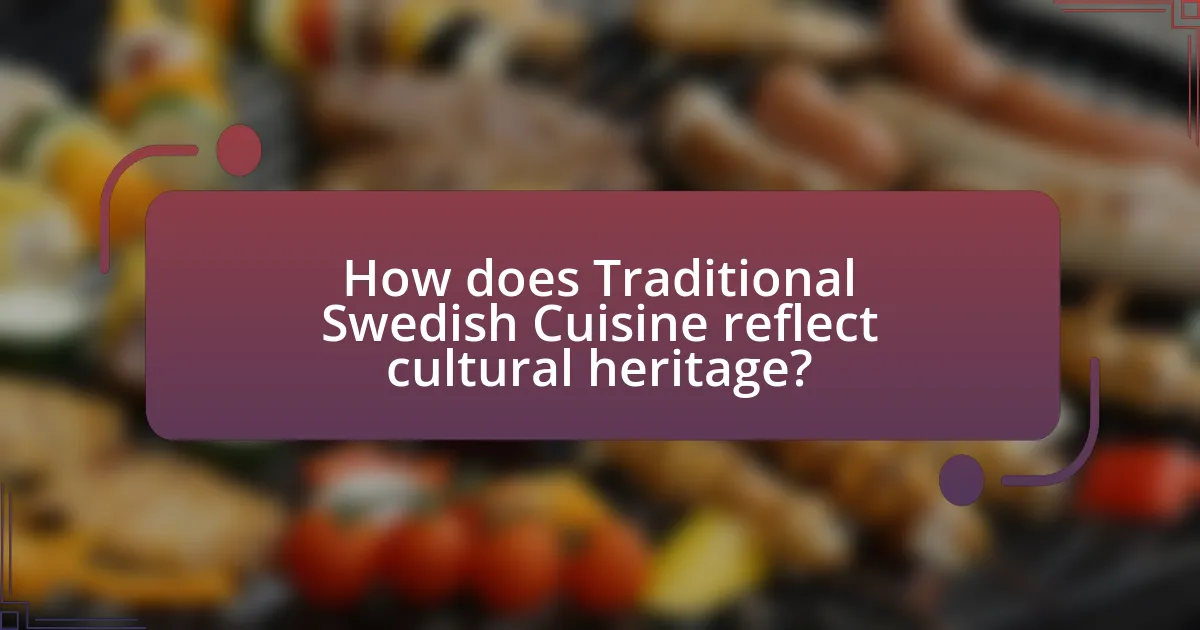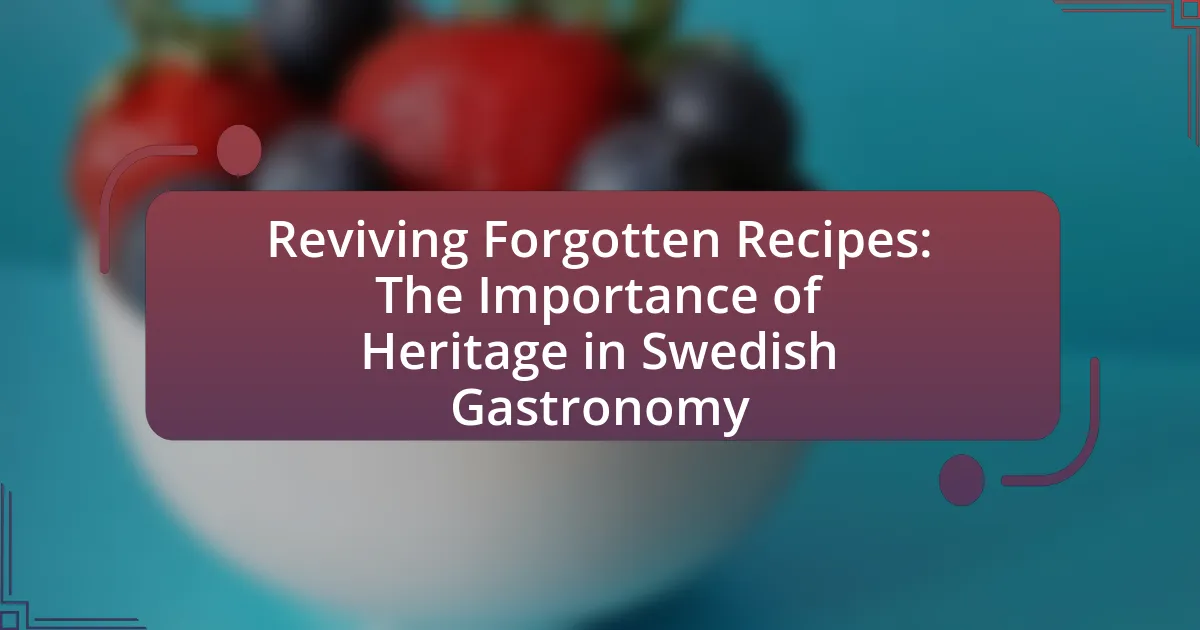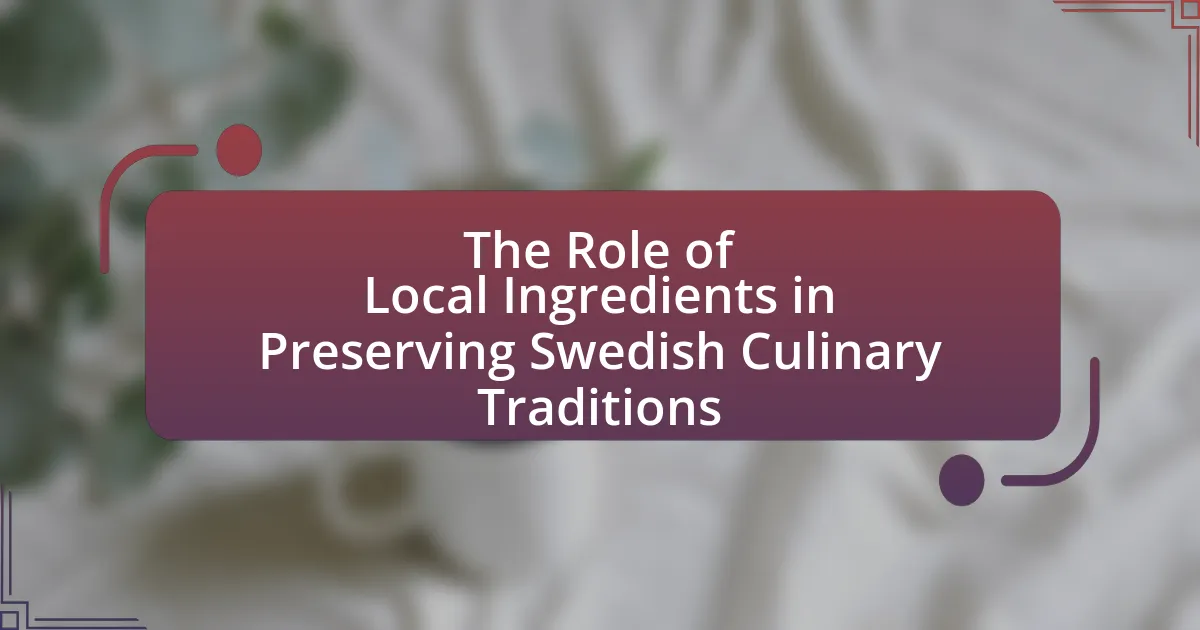Traditional Swedish cuisine is defined by its use of high-quality, locally sourced ingredients and traditional cooking methods, with iconic dishes such as meatballs, herring, and gravlax reflecting the country’s agricultural and maritime heritage. The cuisine has evolved over time, influenced by geography, climate, and cultural exchanges, leading to a diverse array of regional specialties. Key characteristics include an emphasis on simplicity, seasonal ingredients, and preservation techniques, while historical influences have shaped the culinary landscape. Seasonal ingredients play a crucial role in defining traditional dishes, and food is integral to Swedish cultural practices, particularly during family gatherings and celebrations. The article explores these aspects, providing insights into the significance of traditional dishes and how to experience Swedish cuisine today.

What is Traditional Swedish Cuisine?
Traditional Swedish cuisine is characterized by its use of simple, high-quality ingredients and traditional cooking methods. It includes dishes such as meatballs, herring, and gravlax, which reflect the country’s agricultural and maritime heritage. Historical influences, such as the availability of local produce and the impact of neighboring countries, have shaped these culinary practices. For example, the use of preserved fish and root vegetables dates back to the 16th century, highlighting the importance of preservation techniques in Swedish food culture.
How has Traditional Swedish Cuisine evolved over time?
Traditional Swedish cuisine has evolved significantly over time, influenced by geography, climate, and cultural exchanges. Initially, it was characterized by simple, hearty dishes made from locally sourced ingredients, such as fish, game, and root vegetables, reflecting the agrarian lifestyle of the early Swedish people.
During the Middle Ages, the introduction of spices and new cooking techniques from trade routes began to diversify the cuisine. The 19th century saw the rise of industrialization, which led to the availability of processed foods and the incorporation of international flavors, particularly from neighboring countries.
In contemporary times, traditional dishes like meatballs and herring have been adapted to modern tastes, with a growing emphasis on organic and locally sourced ingredients. The global interest in Swedish cuisine has also led to the popularization of traditional foods, such as smörgåsbord and fika, showcasing the blend of historical and modern influences in Swedish culinary practices.
What historical influences shaped Traditional Swedish Cuisine?
Traditional Swedish cuisine has been shaped by various historical influences, including geography, climate, and cultural exchanges. The harsh Nordic climate necessitated preservation methods such as smoking, pickling, and fermenting, which are foundational to Swedish food practices. Additionally, trade routes established during the Viking Age introduced spices and ingredients from other cultures, enriching the local diet. The agricultural practices of the Middle Ages, particularly the cultivation of rye and barley, further defined staple foods in Sweden. Furthermore, the influence of neighboring countries, especially during the Kalmar Union, brought new culinary techniques and dishes, contributing to the evolution of traditional Swedish cuisine.
How do regional variations impact Traditional Swedish Cuisine?
Regional variations significantly impact Traditional Swedish Cuisine by influencing the ingredients, cooking methods, and dishes that are prevalent in different areas. For instance, coastal regions emphasize seafood, leading to dishes like herring and salmon, while inland areas focus on game meats and root vegetables, resulting in hearty stews and casseroles. Historical factors, such as trade routes and agricultural practices, have shaped these regional specialties, with the northern regions utilizing preserved foods like dried fish and cured meats due to harsher climates. This diversity reflects Sweden’s cultural heritage and local resources, showcasing how geography directly affects culinary traditions.
What are the key characteristics of Traditional Swedish Cuisine?
Traditional Swedish cuisine is characterized by its emphasis on simplicity, seasonal ingredients, and preservation methods such as pickling and smoking. This culinary tradition often features staples like fish, particularly herring, alongside root vegetables and grains. Historical influences, including agricultural practices and the availability of local resources, have shaped the cuisine, leading to dishes like meatballs, gravlax, and crispbread. The use of fresh herbs and spices is minimal, reflecting a focus on the natural flavors of the ingredients. Additionally, traditional meals often include communal dining experiences, highlighting the cultural importance of sharing food in Swedish society.
What ingredients are commonly used in Traditional Swedish Cuisine?
Traditional Swedish cuisine commonly uses ingredients such as potatoes, herring, lingonberries, and rye bread. Potatoes serve as a staple side dish, often prepared in various forms like boiled or mashed. Herring, particularly pickled, is a key component in many traditional dishes, reflecting Sweden’s coastal geography and fishing heritage. Lingonberries are frequently used in sauces and jams, providing a tart complement to savory dishes. Rye bread, known for its dense texture and flavor, is a fundamental part of Swedish meals, often served with butter or as a base for open-faced sandwiches. These ingredients highlight the agricultural and maritime influences on Swedish culinary traditions.
How do cooking methods define Traditional Swedish Cuisine?
Cooking methods define Traditional Swedish Cuisine through techniques such as boiling, curing, and baking, which reflect the country’s agricultural practices and climate. For instance, boiling is commonly used for preparing root vegetables and fish, while curing methods, like gravlax, showcase the preservation techniques developed in response to long winters. Baking, particularly of rye bread, is a staple that highlights the importance of grains in Swedish diets. These methods not only influence the flavors and textures of the dishes but also connect to Sweden’s historical reliance on local ingredients and seasonal availability, reinforcing the cultural heritage embedded in the cuisine.
![]()
What are the iconic dishes of Traditional Swedish Cuisine?
The iconic dishes of Traditional Swedish Cuisine include meatballs, herring, gravlax, and lingonberry sauce. Swedish meatballs, known as köttbullar, are typically served with creamy gravy and are a staple in Swedish households. Herring, often pickled, is a common feature in smorgasbord, showcasing the importance of fish in Swedish culinary traditions. Gravlax, a cured salmon dish, is seasoned with dill and sugar, reflecting the country’s seafood heritage. Lingonberry sauce, a tart accompaniment, is frequently paired with meat dishes, highlighting the use of local berries in Swedish cooking. These dishes represent the cultural and historical influences that shape Sweden’s culinary landscape.
What are the most popular traditional Swedish dishes?
The most popular traditional Swedish dishes include meatballs, herring, gravlax, and smörgåsbord. Swedish meatballs, known as köttbullar, are typically served with lingonberry sauce and creamy gravy, reflecting Sweden’s culinary heritage. Herring, often pickled, is a staple in Swedish cuisine, commonly featured in various forms during festive occasions. Gravlax, a cured salmon dish, showcases the importance of fish in Swedish diets and is usually accompanied by mustard sauce. Smörgåsbord, a buffet-style meal, highlights a variety of dishes, emphasizing communal dining and the diversity of Swedish flavors. These dishes are integral to Sweden’s cultural identity and are enjoyed both domestically and internationally.
What is the significance of meatballs in Swedish culture?
Meatballs hold significant cultural importance in Sweden as a traditional dish that symbolizes Swedish culinary heritage. They are often served with lingonberry sauce and creamy gravy, reflecting the balance of flavors typical in Swedish cuisine. Historically, meatballs have been a staple in Swedish households since the 18th century, with variations found across different regions, showcasing local ingredients and cooking methods. The dish is also featured prominently in Swedish celebrations and gatherings, reinforcing its role as a comfort food that brings people together. Additionally, meatballs have gained international recognition, particularly through Swedish furniture retailer IKEA, which has popularized them globally, further embedding their significance in both Swedish identity and global cuisine.
How is herring prepared and served in Sweden?
Herring in Sweden is typically prepared through methods such as pickling, marinating, or frying. The most common preparation involves pickling herring in a brine solution that includes vinegar, sugar, and spices, resulting in a dish known as “sill.” This pickled herring is often served as part of a traditional smorgasbord, accompanied by ingredients like boiled potatoes, sour cream, and crispbread. The practice of pickling herring dates back to the 16th century in Sweden, highlighting its significance in Swedish culinary heritage.
What role do seasonal ingredients play in Traditional Swedish Cuisine?
Seasonal ingredients are fundamental to Traditional Swedish Cuisine, as they dictate the availability and variety of dishes throughout the year. This reliance on seasonal produce reflects Sweden’s agricultural practices and climate, where ingredients like root vegetables, berries, and fish are harvested at specific times. For instance, the summer months bring an abundance of fresh vegetables and berries, which are celebrated in dishes like sill (herring) and various salads, while winter emphasizes preserved foods such as pickled herring and cured meats. This seasonal approach not only enhances flavor and nutrition but also fosters a connection to the land and its cycles, reinforcing cultural traditions and practices in Swedish cooking.
How does the use of seasonal ingredients enhance flavor?
The use of seasonal ingredients enhances flavor by ensuring that produce is harvested at its peak ripeness, which maximizes taste and nutritional value. Seasonal ingredients, such as fresh berries in summer or root vegetables in winter, provide vibrant flavors that are often more intense compared to out-of-season alternatives. For example, studies show that fruits and vegetables grown in their natural season have higher sugar content and better texture, contributing to a more satisfying culinary experience. This principle is particularly evident in traditional Swedish cuisine, where dishes often highlight local, seasonal produce, reflecting the natural cycles of the environment and enhancing the overall flavor profile of the meals.
What are some traditional Swedish dishes associated with specific seasons?
Traditional Swedish dishes associated with specific seasons include herring in spring, crayfish in late summer, and julskinka (Christmas ham) in winter. In spring, herring is often prepared in various pickled forms, celebrating the arrival of the season. During late summer, crayfish parties are common, featuring boiled crayfish seasoned with dill, which is a traditional way to enjoy the harvest. In winter, julskinka, a glazed and spiced ham, is a staple at Christmas feasts, reflecting the festive culinary traditions of Sweden. These dishes highlight the seasonal ingredients and cultural practices that define Swedish cuisine throughout the year.

How does Traditional Swedish Cuisine reflect cultural heritage?
Traditional Swedish cuisine reflects cultural heritage through its emphasis on local ingredients, traditional cooking methods, and historical influences. The use of seasonal and regional produce, such as root vegetables, fish, and game, showcases the connection to Sweden’s natural landscape and agricultural practices. Dishes like herring, meatballs, and crispbread have roots in historical preservation techniques, such as pickling and drying, which were essential for survival during harsh winters. Furthermore, the influence of various cultural exchanges, including trade and migration, has shaped the culinary landscape, integrating flavors and techniques from neighboring countries. This blend of local resources and historical practices illustrates how traditional Swedish cuisine serves as a living testament to the nation’s cultural identity and heritage.
What cultural practices are associated with Traditional Swedish Cuisine?
Traditional Swedish cuisine is closely associated with cultural practices such as the celebration of seasonal festivals, the use of local ingredients, and communal dining experiences. Seasonal festivals like Midsummer and Christmas involve specific traditional dishes, such as herring, meatballs, and gravlax, which reflect the agricultural calendar and local produce. The emphasis on local ingredients is rooted in Sweden’s geography and climate, promoting sustainability and a connection to the land. Communal dining practices, exemplified by the concept of “smörgåsbord,” encourage sharing and social interaction, highlighting the importance of community in Swedish culture. These practices collectively reinforce Sweden’s culinary identity and heritage.
How do holidays influence the preparation of traditional dishes?
Holidays significantly influence the preparation of traditional dishes by dictating specific recipes, ingredients, and cooking methods that are culturally associated with those celebrations. For instance, in Sweden, the Christmas holiday prompts the preparation of dishes like julskinka (Christmas ham) and köttbullar (meatballs), which are integral to festive meals. These dishes often utilize seasonal ingredients, such as root vegetables and spices, that reflect the time of year and local agricultural practices. Additionally, historical customs and family traditions shape the way these dishes are prepared, ensuring that recipes are passed down through generations, thus preserving cultural heritage.
What role does food play in Swedish family gatherings and celebrations?
Food plays a central role in Swedish family gatherings and celebrations, serving as a means of connection and cultural expression. Traditional dishes such as meatballs, herring, and gravlax are often featured, reflecting Sweden’s culinary heritage and regional ingredients. These meals foster a sense of togetherness, as families gather to share recipes and stories, reinforcing familial bonds and cultural identity. Celebrations like Midsummer and Christmas prominently feature specific foods, highlighting their importance in marking seasonal traditions and communal experiences. The act of preparing and enjoying food together during these occasions strengthens relationships and preserves cultural practices across generations.
How can one experience Traditional Swedish Cuisine today?
One can experience Traditional Swedish Cuisine today by visiting authentic Swedish restaurants or participating in culinary tours that focus on traditional dishes. These establishments often serve classic meals such as meatballs, herring, and gravlax, prepared using age-old recipes and local ingredients. For instance, restaurants like Pelikan in Stockholm are renowned for their adherence to traditional cooking methods and recipes, offering a genuine taste of Swedish culinary heritage. Additionally, food festivals and markets, such as the Skansen Market, provide opportunities to sample various traditional foods and learn about their cultural significance.
What are the best ways to explore Traditional Swedish Cuisine in Sweden?
The best ways to explore Traditional Swedish Cuisine in Sweden include visiting local markets, dining at traditional restaurants, participating in food festivals, and taking cooking classes. Local markets, such as Östermalm Market Hall in Stockholm, offer a variety of authentic Swedish ingredients and dishes, allowing visitors to experience the local food culture firsthand. Traditional restaurants, like Smorgastarteriet in Malmö, serve classic dishes such as herring, meatballs, and gravlax, providing a taste of Sweden’s culinary heritage. Food festivals, such as the annual Småland Food Festival, showcase regional specialties and local producers, enhancing the exploration of Swedish flavors. Cooking classes, available in cities like Gothenburg, allow participants to learn how to prepare traditional dishes, deepening their understanding of Swedish culinary techniques and ingredients.
How can international travelers enjoy Traditional Swedish Cuisine at home?
International travelers can enjoy Traditional Swedish Cuisine at home by sourcing authentic ingredients and following traditional recipes. For instance, they can prepare dishes like meatballs (köttbullar) using ground beef, pork, breadcrumbs, and spices, which are staples in Swedish cooking. Additionally, travelers can recreate classic accompaniments such as lingonberry sauce and creamy gravy, which are essential for an authentic experience. Access to Swedish food products has increased, with many online retailers offering items like pickled herring and crispbread, allowing for a genuine taste of Sweden. Furthermore, cooking classes or online tutorials focused on Swedish cuisine can provide valuable guidance and enhance the cooking experience, ensuring that international travelers can replicate the flavors of Sweden in their own kitchens.
What tips can enhance your experience with Traditional Swedish Cuisine?
To enhance your experience with Traditional Swedish Cuisine, focus on trying a variety of dishes, including classic options like meatballs, herring, and gravlax. Engaging with local food traditions, such as enjoying a smorgasbord, allows for a comprehensive taste of Sweden’s culinary heritage. Additionally, pairing meals with traditional beverages like aquavit or Swedish cider can elevate the dining experience. Exploring regional specialties, such as the unique flavors of Swedish pastries like kanelbullar (cinnamon buns), further enriches your culinary journey. These practices are rooted in Sweden’s rich food culture, which emphasizes seasonal ingredients and communal dining experiences.





